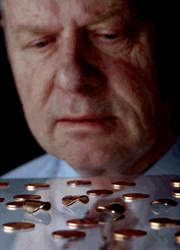‘Fuzzy’ algebra offers hard-core data for nuclear weapons safety probabilities
One day about five years ago a safety analyst presented Arlin Cooper of High Consequence Surety Engineering Dept. 12331 an analysis of the safety probability of a nuclear weapon precise to three decimal points. Arlin, who routinely reviews safety analyses, was astounded. How, he asked, could anyone know so exactly how safe a device was when so many variables — like the possibility of human error or faulty parts– were uncertain?

Download 150dpi JPEG image, ‘fuzzy_pix.jpg’, 1 Mb
That question led him on a quest to find a better way to account for safety uncertainties. While researching the matter at Sandia’s technical library in 1993, he encountered a seldom-used concept, fuzzy algebra (a derivative of fuzzy logic), which can incorporate subjective uncertainties in mathematical equations.
"I became intrigued," Arlin says. "This method of computing subjective uncertainty seemed more tied to reality than traditional statistics. It took in all the uncertainties and made no unwarranted assumptions."
Arlin says that it is one thing to make predictions about safety — whether it is nuclear weapons or jetliners — using standard statistics if you know for certain that there is a physical basis. It’s another when you have to factor in uncertainties that can only be expressed subjectively.
Fuzzy algebra
That’s where fuzzy algebra comes in.
In the traditional mathematical model, probabilities are estimated by clear-cut equations or by precisely defined probability distributions. Data are dumped into computer routines and point numbers or probability distributions are calculated.
The problem, Arlin says, is that typically only the analyst doing the computations knows which data are assumed and which are physically justified.
Traditional statistics vs. fuzzy algebra
"The resulting probability analyses go to decision makers who may be unaware of the nature of the uncertainties and make decisions based on the figures given to them," he says.
In explaining the difference between traditional statistics and fuzzy algebra, he uses the example of the probability of throwing four heads in four coin tosses. Traditional analysis says that the probability is 1/16, and this might be viewed as an acceptably small risk for a gambler. But what happens if the consequences of losing are raised beyond what is acceptable — say to loss of life?
Would the gambler then be interested in knowing more about the coins and how they were tossed? How does the probability change if the coins have been subjected to an "abnormal environment" (stresses beyond the operating environment) and are significantly warped or deformed and where there are limited physical data or tests? Knowing more about the coins and how they can fail to perform in a predictable way is analogous to the safety analyst wanting to know how safety devices in high-consequence systems can fail.
A traditional analyst might select one or more distribution equations to determine the probability of the coins falling heads up — a guessing game of sorts. The distribution equations then shape the outcome of the probability analysis, resulting in a phenomenon called "tail (extremes) suppression."
A fuzzy algebra approach, however, takes into account qualitative judgments by "experts" who in the example might view the warped coins and come up with their own separate range estimates about how frequently the coins will land heads up. These predictions are plugged into a fuzzy function, a two-dimensional portrayal of range that represents a continuum from the lowest to the highest levels of presumption.
The true consensus on how often the coins would land on heads lies somewhere within the fuzzy function. Instead of an exact point or probability distribution like in traditional analysis, fuzzy algebra provides a subjective-based range. The process avoids tail suppression, a potential source of over-optimism.
"It may not be a satisfying answer because it is not precise, but it’s an honest answer," Arlin says.
As more and more information is received — for example if exact measurements about the way the warped coins fall are determined — the fuzzy math approach can transition toward the probabilistic approach.
"You will start out with as low as 10 percent hard data and 90 percent subjective data," Arlin says. "And as you strive to get better information, the numbers may eventually turn completely around to 90 percent hard data and 10 percent subjective."
Approach suits safety analyses
Arlin says this hybrid approach perfectly suits safety probability analyses because while there may be some well-defined physical responses, there are also a lot of highly uncertain events — ranging from human failure to lightning strikes — that can threaten a nuclear weapon. By having experts analyze what those problems might be and processing them in a hybrid analysis, it is possible to come up with realistic estimates.
Arlin’s manager, Perry D’Antonio, is enthusiastic about Arlin’s endeavors to find an improved method of doing probability analyses, agreeing that current procedures don’t properly take into account subjective assumptions.
"Arlin looked at what others were doing and found a possible solution to a major problem — coming up with a real probability description that doesn’t overstate safety," Perry says. "In the business of safety you have to be cautious about what you might have forgotten to include, and you can’t assume anything unjustified."